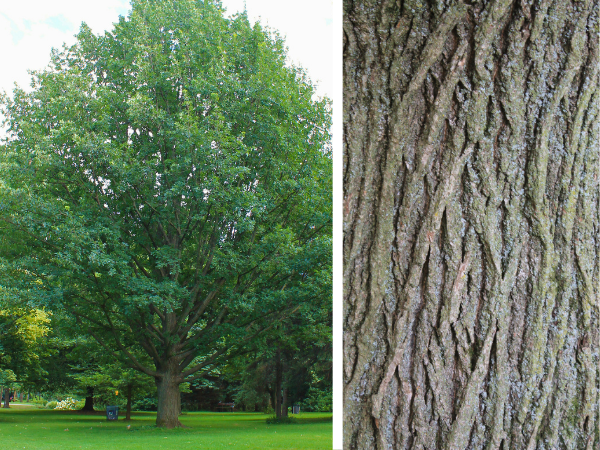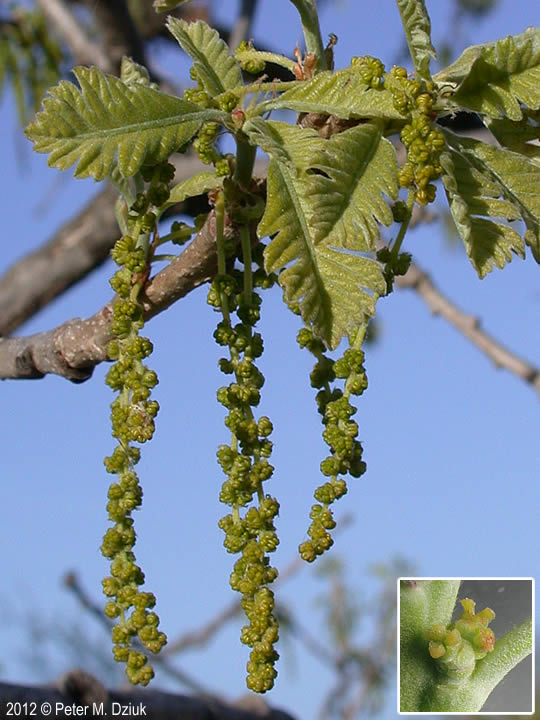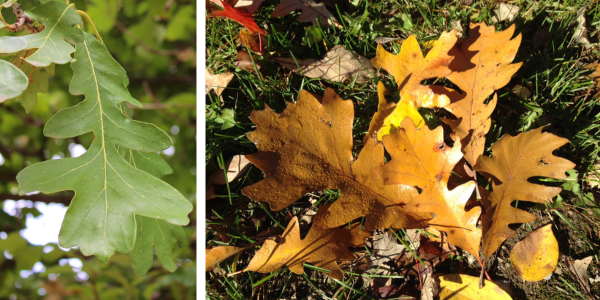Also known as the mossy cup oak, the bur oak’s common name aptly reflects one of its most identifiable characteristics – the acorn! The name bur oak refers to the fringed, bur-like bristles on top of the tree’s acorns, which is also how it gets its other common name, mossy cup oak! Similarly, the Latin name (Quercus macrocarpa) also references the acorns. The Genus Quercus comes from the classic Latin name for oaks and the specific epithet, macrocarpa, comes from the Greek words makros, meaning large and karpos, meaning fruit, referring to the bur oak’s large acorn size!

The bur oak’s broad, rounded crown with open to wide spreading branches allows it to reach an average height of about 50 feet in an urban area, making it the perfect shade tree and nesting habitat for birds, such as cedar waxwings, nuthatches, owls, tanagers, blue jays and eastern kingbirds. Light grey-brown when young, the bark matures to a darker grey colour with rough, deeply furrowed ridges and rugged, corky branches that give the tree a distinct, stately look.

In addition to its notable strength, the bur oak also has several unique characteristics that set it apart from other native trees. To start, it is monoecious, meaning that it has both male and female reproductive organs on the same tree! Both emerging in the spring, the yellowish-green, slender male flowers present themselves as long, drooping catkins and the greenish-red, female flowers emerge as spikes. The female flowers make way for the very distinguishable acorns, which are green to brown in colour with furry (or burry!) caps. They mature in the late summer/early fall each year, creating a high calorie snack for small mammals such as squirrels and chipmunks.

In Ontario, oaks are typically divided into two main groups based on their leaves: the red oak group and the white oak group (not to be confused with the red oak species and the white oak species). Trees in the red oak group have pointed lobes whereas trees in the white oak group have more rounded lobes. The bur oak belongs to the white oak group, with its irregularly rounded lobes and deep sinuses (indents) near the centre of the leaf, making the leaf appear as if it is divided into two! The simple leaves are arranged alternatively along the branches and are a dark green colour above and a pale, fuzzy green colour below, providing a tasty treat for northern and white Hairstreak and Duskywing butterfly caterpillars. The fall colour can vary anywhere from a yellow to a bright golden bronze, which looks exceptionally beautiful against a bright blue autumn sky!

If you like the idea of planting a champion tree in your yard, the bur oak is an A-oak-kay choice for you! Check out our Backyard Tree Planting Program and sign up for a consultation with one of our arborist today!
Brenna Anstett is the Residential Planting Programs Manager and an ISA certified arborist at LEAF.
LEAF offers a subsidized Multi-Unit & Business Planting Program for private property. The program is supported by the City of Toronto, the Regional Municipality of York, the City of Markham, the Town of Newmarket, the Regional Municipality of Durham, the Town of Ajax, the Township of Brock, the Municipality of Clarington, the City of Oshawa, the City of Pickering, the Township of Scugog, the Town of Whitby, Ontario Power Generation and Ontario Trillium Foundation.
